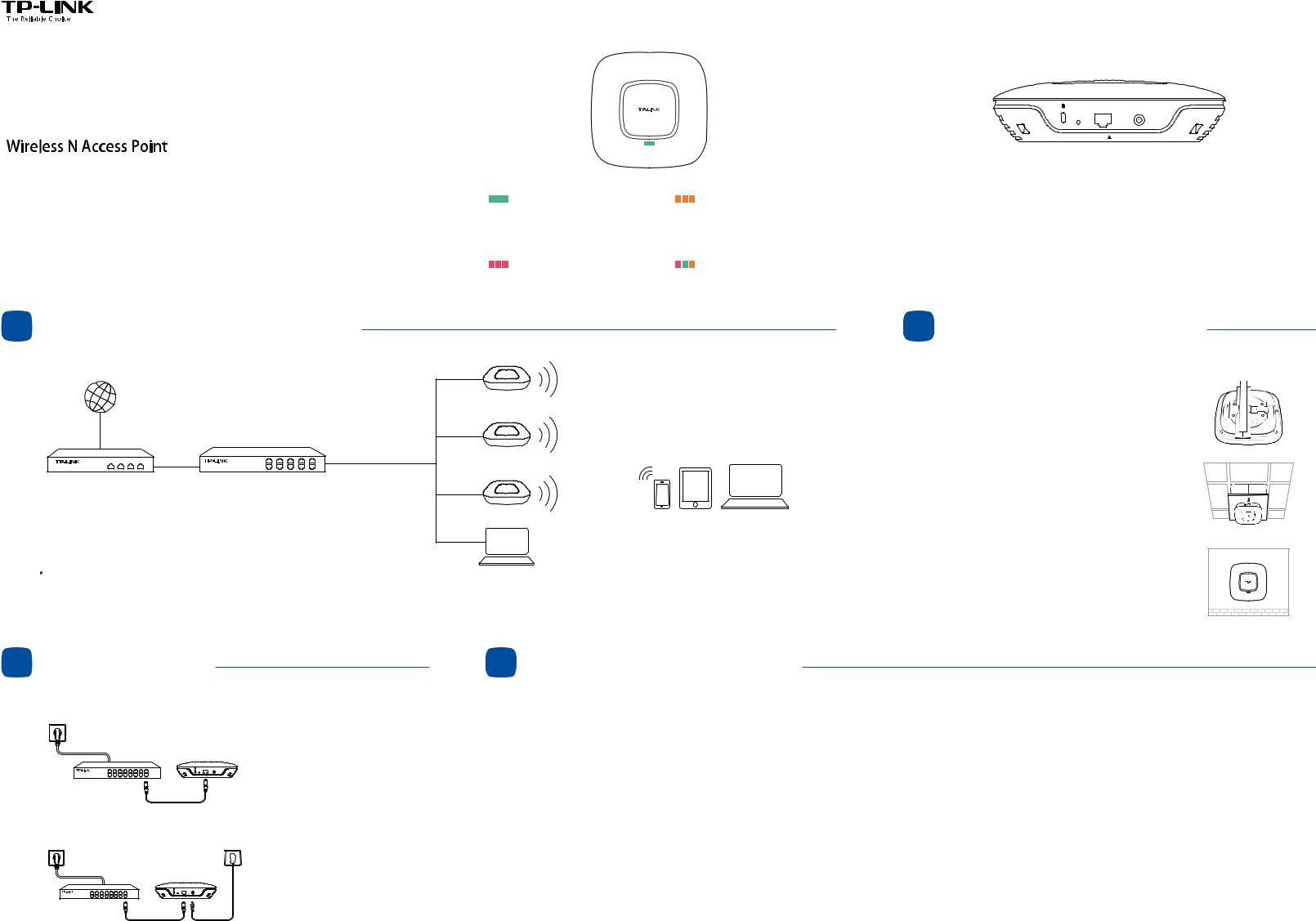Tp-link EAP115 User Manual

Quick Installation Guide
EAP115
7106506355 REV1.0.0
LED Indication
Solid green
The device is working properly.
Flashing red
System errors. RAM, Flash, Ethernet, WLAN or firmware may be malfunctioning.
Flashing yellow
Firmware update is in progress. Do not disconnect or power off the device.
Double-flashing red, green, yellow
The device is being reset to its factory default settings.
1 Typical Network Topology
Internet
EAP
EAP
Router |
Switch |
EAP |
Clients |
|
A DHCP server (typically a router) is required to assign IP addresses to the EAPs and clients in your local network. |
Manangement Host |
|
 The management host can be in the same or different network segment with the EAPs.
The management host can be in the same or different network segment with the EAPs.
Interface Panel
RESET |
ETHERNET |
POWER |
RESET
With the device powered on, press and hold the button for about 8 seconds until the LED flashes red, then release the button. The device will restore to factory default settings.
ETHERNET
The port is used to connect to a router or a switch to transmit data or to a PSE (Power Sourcing Equipment), such as a PoE switch, for both data transmission and Power over Ethernet (PoE) through Ethernet cabling.
2 Hardware Installation
The EAP can be ceiling rail mounted, ceiling-mounted, or wall-mounted.
The instructions for various mounting options are on the back of this Quick Installation Guide.
Option 1: Ceiling Rail Mounting
Option 2: Ceiling Mounting
Option 3: Wall Mounting
3 Power Supply
The EAP can be powered via a PSE device (such as a PoE switch) or a power adapter.
Via PoE Switch
PoE Switch
Connect an Ethernet cable from the PoE switch to the ETHERNET port.
Via Power Adapter
PoE Adapter
Switch
Plug one end of the provided power adapter into the POWER port of the EAP and the other end to a standard electrical wall outlet.
4 Software Configuration
To quickly set up a wireless network connection with mass EAPs, you can manage the EAPs via EAP Controller or in Cluster mode.
Via EAP Controller
Note: The IP address of the management host must be reachable for the EAPs in the network. In this example, the management host is in the same LAN with the EAPs.
Step 1: Installing the EAP Controller
On the management host, download the EAP Controller installation file from the product support page at www.tp-link.com. Run the file and follow the wizard to install the EAP Controller.
Step 2: Configuring the EAP Controller
Launch the EAP Controller and follow the configuration wizard to create a primary wireless network. After the wizard is finished, a login screen will appear. Enter the Admin name and password you created and click Sign In.
Step 3: Adopting the EAP devices
Adopt the EAP devices in the Controller management interface to change their status from pending to connected.
For More Configurations
Now you can manage your wireless network and view network statistic using the EAP Controller. Please refer to the EAP Controller User Guide to learn more information about configuring and using the Controller software.
Via Cluster Mode
Note: 1. The EAPs forming a cluster must be of the same model and in the same LAN.
2.EAPs with the same cluster name will form a cluster.
3.The management host must be in the same LAN with the EAPs.
Step 1: Logging in to the EAP
On the management host, open a browser and type the IP address (assigned by the DHCP server) of the EAP in the address field, and press the Enter key. Fill in admin (all lowercase) for both username and password to login.
Step 2: Choosing the Work Mode
Choose the work mode as Cluster in the drop-down box, the EAP will reboot and switch to Cluster mode. The EAPs with the same cluster name will form a cluster and one of them will be elected as the Master EAP automatically.
Step 3: Managing the EAPs
On the management host, log in to to any EAP’s IP address and you will be redirected to the Master EAP’s web manmgement page, where you can manage each EAP in the cluster.
For More Configurations
Now you can manage your wireless network and view network statistic in cluster mode. Please refer to the EAP User Guide to learn more information about Cluster mode.
